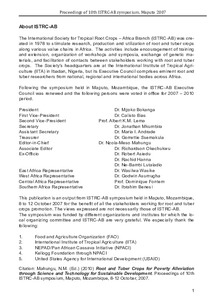| dc.contributor.author | Tata-Hangy, K.W. |
| dc.contributor.author | Legg, J.P. |
| dc.contributor.author | Lema, K.M. |
| dc.contributor.author | Hanna, R. |
| dc.contributor.author | Luyindula, N. |
| dc.date.accessioned | 2019-12-04T11:10:59Z |
| dc.date.available | 2019-12-04T11:10:59Z |
| dc.date.issued | 2010 |
| dc.identifier.citation | Tata-Hangy, K., Legg, J.P., Lema, K.M., Hanna, R. & Luyindula, N. (2010). The incidence of the cassava mosaic disease in relation with the source of planting materials and its impact on cassava production. In Proceedings of the 10th Symposium of ISTRC-AB in Mozambique: root and tuber crops for poverty alleviation through science and technology for sustainable development, (p. 371-379), 6-12 October, Maputo. |
| dc.identifier.isbn | 99951-60-00-5 |
| dc.identifier.uri | https://hdl.handle.net/20.500.12478/2319 |
| dc.description.abstract | An experiment was conducted over two years (in 2004 and 2005) at the research station of the National Institute of Agricultural Study and Research (INERA) in Mvuazi, Bas-Congo province to determine the incidence of the cassava mosaic disease (CMD) in relation to the source of planting material and its impact on cassava yield. In the first year, two treatments were assessed, (1) healthy cuttings obtained from plots managed with phytosanitation through rouging and, (2) cuttings collected at random from a farmer-managed cassava field. Three cassava varieties were used in the study: Boma, a local cultivar susceptible to CMD, RAV, an improved variety moderately resistant, and Mahungu, which has a high level of resistance. A third treatment was added to the trial in the second year and was constituted of cuttings free from CMD symptoms, collected from the plots where healthy cuttings were planted in the first year. The results indicated that the use of healthy cuttings prevents the crop from primary CMD infections, delays the development of the disease and reduces its incidence. Disease incidence reached 100% of diseased plants at only 4 months after planting (MAP) for the susceptible variety Boma in plots planted with cuttings from farmer –managed plots, and at 7 MAP in plots planted with healthy cuttings from fields managed with phytosanitation. On the moderately resistant variety RAV, the disease reached 100% of the plants at 5 MAP in plots planted with farmer’s cuttings, while in plots with healthy cuttings, the final incidence was 60.7% at 10 MAP. For the resistant variety Mahungu, disease incidence was 78,1% and 10% at 10 MAP, respectively on plants from farmer’s cuttings and on those from healthy cuttings. In the second year, the trend of the results was similar to that of the first year. The development of the disease and the final incidence were lower on the resistant variety Mahungu in all the treatments in both years of the study, indicating that the resistant variety is the best solution for a sustainable CMD management. The use of clean cuttings also substantially improved the growth of the plants as well as the yield of tuberous roots on all the three varieties used in the experiment. An increase of 58% and 63% was observed in the yield of the variety RAV and Mahungu, respectively, when clean cuttings were used in comparison with the yield of the farmer’s cuttings. |
| dc.format.extent | 371-379 |
| dc.language.iso | en |
| dc.publisher | International Institute of Tropical Agriculture |
| dc.subject | Cassava |
| dc.subject | Diseases |
| dc.subject | Yield |
| dc.subject | Democratic Republic Of Congo |
| dc.title | The incidence of the cassava mosaic disease in relation with the source of planting materials and its impact on cassava production |
| dc.type | Conference Paper |
| dc.description.version | Peer Review |
| cg.contributor.affiliation | Institut National pour l'Etude et la Recherche Agronomique |
| cg.contributor.affiliation | International Institute of Tropical Agriculture |
| cg.coverage.region | Africa |
| cg.coverage.region | East Africa |
| cg.coverage.country | Congo, Dr |
| cg.authorship.types | CGIAR and developing country institute |
| cg.iitasubject | Cassava |
| cg.howpublished | Formally Published |
| cg.publicationplace | Ibadan, Nigeria |
| cg.accessibilitystatus | Limited Access |
| local.dspaceid | 92012 |
| cg.targetaudience | Scientists |

